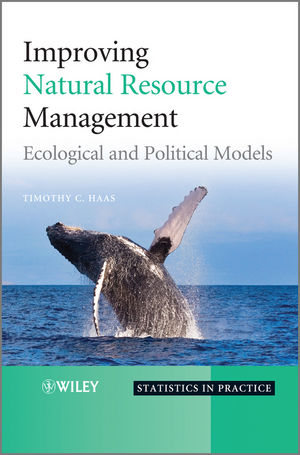Improving Natural Resource Management: Ecological and Political ModelsISBN: 978-0-470-66113-0
Hardcover
272 pages
March 2011
 |
||||||
List of Figures.
List of Tables.
Nomenclature.
Part I Managing a Political-Ecological System.
1 Introduction.
1.1 The Problem to be Addressed.
1.2 The Book's Running Example: East African Cheetah.
1.3 The EMT's Simulator.
1.4 How to Use the EMT to Manage an Ecosystem.
1.5 Chapter Topics and Order.
1.6 The Book's Accompanying Web Resources.
2 Simulator Architecture, Operation, and Example Output.
2.1 Introduction.
2.2 Theory for Agent-Based Simulation.
2.3 Action Messages and IntIDs Model Operation.
2.4 A Plot for Displaying an Actions History.
2.5 Conclusions.
2.6 Exercises.
3 Blue Whale Population Management.
3.1 Introduction.
3.2 Current Status of Blue Whales.
3.3 Groups that Affect Blue Whale Populations.
3.4 Blue Whale Ecosystem ID.
3.5 Interactions Between IDs.
3.6 Data Sets for the Blue Whale EMT.
3.7 Main Points of this Chapter's Example.
3.8 Exercises.
4 Finding the Most Practical Ecosystem Management Plan.
4.1 Introduction.
4.2 Some Methods for Developing Ecosystem Management Plans.
4.3 Consistency Analysis Parameter Estimator Overview.
4.4 The MPEMP: Definition and Construction.
4.5 The MPEMP for East African Cheetah.
4.6 Conclusions.
4.7 Exercises.
5 An Open, Web-Based Ecosystem Management Tool.
5.1 Introduction.
5.2 Components of a Politically Realistic EMT.
5.3 Id Language and Software System.
5.4 How the EMT Website Would be Used.
Part II Model Formulation, Estimation, and Reliability.
6 Influence Diagrams of Political Decision Making.
6.1 Introduction.
6.2 Theories of Political Decision Making.
6.3 Architecture of a Group Decision Making ID.
6.4 Related Modeling Efforts.
6.5 Conclusions.
6.6 Exercises.
7 Group IDs for the East African Cheetah EMT.
7.1 Introduction.
7.2 Country Backgrounds.
7.3 Selection of Groups to Model.
7.4 President IDs.
7.5 EPA IDs.
7.6 Rural Residents IDs.
7.7 Pastoralists IDs.
7.8 Conservation NGOs ID.
7.9 Conclusions.
7.10 Exercises.
8 Modeling Wildlife Population Dynamics with an Influence Diagram.
8.1 Introduction.
8.2 Model of Cheetah and Prey Population Dynamics.
8.3 Solving SDEs within an ID.
8.4 Example of Ecosystem ID Output.
8.5 Conclusions.
8.6 Exercises.
9 Political Action Taxonomies, Collection Protocols, and an Actions History Example.
9.1 Introduction.
9.2 Political Action Taxonomies.
9.3 Adapting the BCOW Taxonomy to Ecosystem Management Actions.
9.4 EMAT Coding Protocol.
9.5 Actions History Data for the East African Cheetah EMT.
9.6 Conclusions.
10 Ecosystem Data.
10.1 Introduction.
10.2 Wildlife Monitoring.
10.3 Wildlife Abundance Estimation Methods.
10.4 East African Cheetah Prey Abundance Data.
10.5 Data on Cheetah Habitat Suitability Nodes.
10.6 Conclusions.
10.7 Exercises.
11 Statistical Fitting of the Political-Ecological System Simulator.
11.1 Introduction.
11.2 Consistency Analysis Applied to an Actions History.
11.3 Consistency Analysis of the East African Cheetah EMT Simulator.
11.4 Conclusions and Another Collection Initialization Algorithm.
11.5 Exercises.
12 Assessing the Simulator's Reliability and Improving Its Construct Validity.
12.1 Introduction.
12.2 Steps for Assessing Simulator Reliability.
12.3 Sensitivity Analysis.
12.4 One-Step-Ahead Prediction Error Rates.
12.5 MC Hypothesis Tests.
12.6 Sensitivity to Hidden Bias Analysis.
12.7 Conclusions.
12.8 Exercises.
Part III Assessment.
13 Current Capabilities and Limitations of the Politically Realistic EMT.
13.1 Introduction.
13.2 Current Capabilities of the EMT.
13.3 Current Limitations of the EMT.
13.4 Supporting the EMT in the Real World.
13.5 Consequences of Using a Politically Realistic EMT.
Appendices.
Appendix A Heuristics Used to Assign Hypothesis Values to Parameters.
Appendix B Cluster Computing Version of Hooke and Jeeves Search.
References.
Index.



